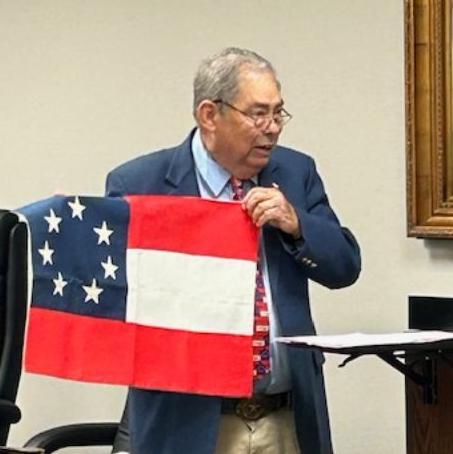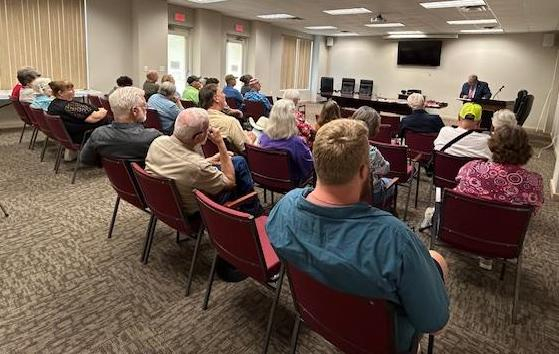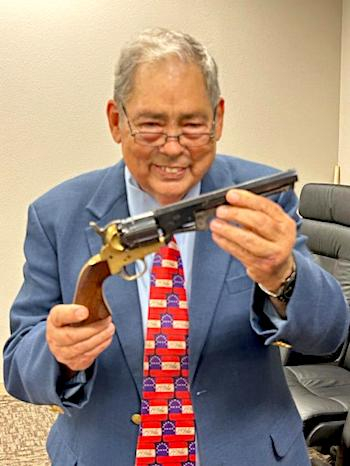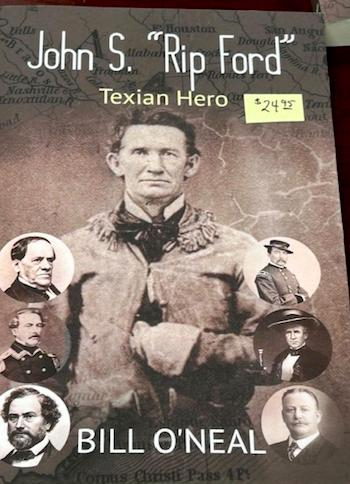
Bill O'Neal
June 28, 2024 - Author and former Texas State Historian Bill O'Neal felt that since the last battle of the Civil War was fought in Texas and the reading of the Emancipation Proclamation in Galveston on June 19, 1865 brought the news of the end of their enslavement, Texas and the Civil War was an appropriate Junteenth topic. Speaking to a large audience at the June monthly meeting of the Timpson Area Genealogical and Heritage Society last Wednesday, O'Neal began by saying “Just as World War II was the biggest event of the twentieth century, the Civil War was the biggest event in nineteenth century American history.
“Texas had become a state in 1845 and became the fastest growing state in the Union. The 1850 Census revealed a Texas population of 212,592 but by the 1860 Census Texas population had almost tripled to 604,215. Cotton was Texas' primary cash crop and by 1880 Texas was the largest producer of cotton in the U.S. Slavery was a big part of cotton culture and in 1860, thirty percent of Texas population was enslaved persons. The county in Texas with the most slaves was Harrison County but seventy percent of Texans didn't own slaves. Of the thirty percent of Texans who owned slaves, most owned only one or two. Those who owned dozens were known as planters and they were wealthy and powerful. They could afford to hire an overseer to run the plantation which gave them time to become county judges, state legislators, and hold other important offices. As a result, slave-owners controlled Texas politics,” O'Neal shared. “This was true throughout the South.”

“The slave-owners had felt increasingly threatened by the rise of Abolitionist sentiment in the North. This came to a head with the election of Republican Abraham Lincoln to the Presidency in 1860,” O'Neal continued. “The summer of 1860 was hot and dry in Texas and there was an outbreak of prarie fires. Even though prairie fires were not uncommon, suspicion that Yankees were responsible were prevalent that summer. There was also a rash of horse thefts during this same time and, once again, Yankees were thought to be responsible. Though baseless, these suspicions fueled anti-Union feelings.”
“Because Texas had a huge exposed frontier to the west, subject to bandito and Comanche raids, the Federal government had build a string of forts in West Texas, the first of which was Fort Worth. Eventually thirty of these forts were built, housing about 3000 Union soldiers, which was ten percent of the Union Army at the time. Among them was an officer named Robert E. Lee. Although his family remained in Virginia, Lee's last Union duty station prior to the Civil War was in Texas,” O'Neal revealed. “Once the war started, these forts were abandonded, leaving the Texas frontier open to marauding bandidos, Comanches, and Kiowas. Our western counties were hammered by these groups during the Civil War. In the 1840s we had had the Regulator-Moderator War in East Texas as well as a number of blood feuds between families. There were outlaw gunmen who killed with little provocation, such as Cullen Baker from the Linden area and Ben Thompson from Austin. Life was violent and harsh in Texas and the notion of war did not frighten Texans as much as the citizens of eastern states. These factors were favorable to the secessionist movement in Texas,” O'Neal stated. “'One Texan can whip ten of those damn Yankees!' was a popular sentiment.”

“The Presidential Election of 1860 saw the Democratic Party split into three factions, while the new Republican Party united behind Abraham Lincoln and an anti-slavery platform, ensuring Lincoln's victory, ” O'Neal continued. “Pro-slavery elements in the South felt that this was the last straw and within two weeks of Lincoln's victory, influential pro-slavery citizens in Texas met in Austin to organize for secession, including a parade down Congress Avenue to the Capitol. The Governor of Texas was Sam Houston and he had fought too hard to see Texas become part of the United States to support succession. He was a strong Unionist and had delivered a fiery anti-secession speech in the U.S. Congress years before anyone had ever heard of Abraham Lincoln. Nevertheless, 76% of Texans voted to secede from the Union in a general election early in 1861 over Houston's opposition. The date of secession was March 2, 1861 and Texas joined the Confederacy on March 10. When Houston was called upon to swear an oath of allegiance to the Confederacy he refused and the Legislature declared the Office of Governor vacant. Houston and his family left Austin for Huntsville and he would die two years later at age 70.”
“Of about 90,000 men of military age in Texas, about 70,000 served, though some were younger and older. No major Civil War battles were fought in Texas so most of the Texans fought elsewhere. 82.3% of the First Texas Infantry Regiment was killed or wounded at Antietam. Two Confederate Major Generals were from Texas, Albert Sydney Johnson and John Bell Hood. Johnson would be killed at the Battle of Shiloh. Ironically, a Texan fighting for the Union won the Medal of Honor during the Civil War. Milton Holland had left Panola County and gone north because he did not support secession. A Confederate recruitment camp was established outside Tyler and named Camp Ford, after San Augustine resident Rip Ford. Camp Ford later became the largest Confederate POW camp west of the Mississippi.” O'Neal revealed. “All the while, the Texas frontier, bereft of the protection of the Federal forts to the west, were subject to constant raids by hostile Indians.”

“My favorite battle of the Civil War occurred in Texas, the Battle of Sabine Pass,” O'Neal declared. “In an effort to prevent entry to the Sabine River, we had built a little earthwork fort at Sabine Pass which was armed with six cannons. It was manned by militia companies out of Houston, who would come out and stay for a month and practice. They were commanded by a saloon keeper from Houston named Dick Dowling. With little to do but practice with their cannons, they became very proficient. In September of 1863, the Union Army attempted to enter the Sabine River with a number of gunboats and about 5000 troops. When the Union ships came into range, the Confederates opened fire with their cannons, sinking two of the three lead gunboats and blocking the channel. The Union troops were forced to withdraw. On that day, 42 Texans defeated 5000 Yankees!” laughed O'Neal. “A second attempt was made to invade Texas by Union troops coming up the Red River in Louisiana, but they were defeated at the Battle of Mansfield.”
“The final land battle of the Civil War was fought in Texas at Palmito Ranch, on the banks of the Rio Grande near Brownsville. Confederate troops under Col. Rip Ford defeated a large contingent of Unions soldiers who had come to assume control of the area. Robert E. Lee had surrendered a month earlier at Appomattox Courthouse, on June 9, 1865 and Union forces under General Grainger arrived in Galveston, where the Emancipation Proclamation was publicly read on June 19. Although the South lost the Civil War, historians regard the defense of Texas and her coast as the most successful part of the Confederate campaign. Texas was never taken by the Union Army,” O'Neal concluded.
The Timpson Area Genealogical Society meets at 2PM on the third Wednesday of each month in the meeting room of the Timpson Public Library on the corner of Austin and Bremond Streets in downtown Timpson. The TAGHS library is located within the Timpson Public Library and is open and staffed from 9AM until 5PM weekdays. Telephone 936-254-2966 and ask for the Genealogical Library.









